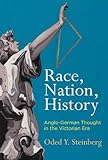Race, Nation, History : Anglo-German Thought in the Victorian Era / Oded Y. Steinberg.
Material type: TextSeries: Intellectual History of the Modern AgePublisher: Philadelphia : University of Pennsylvania Press, [2019]Copyright date: ©2019Description: 1 online resource (296 p.)Content type:
TextSeries: Intellectual History of the Modern AgePublisher: Philadelphia : University of Pennsylvania Press, [2019]Copyright date: ©2019Description: 1 online resource (296 p.)Content type: - 9780812296235
- online - DeGruyter
| Item type | Current library | Call number | URL | Status | Notes | Barcode | |
|---|---|---|---|---|---|---|---|
 eBook
eBook
|
Biblioteca "Angelicum" Pont. Univ. S.Tommaso d'Aquino Nuvola online | online - DeGruyter (Browse shelf(Opens below)) | Online access | Not for loan (Accesso limitato) | Accesso per gli utenti autorizzati / Access for authorized users | (dgr)9780812296235 |
Frontmatter -- Contents -- Introduction. Racial Time -- Chapter 1. The English Teutonic Circle -- Chapter 2. Roman Decline and Teutonic Rejuvenation: The Racial German and English Gemeinschaft of Scholars (1850–90) -- Chapter 3. Racial History: The Convergence of Race and Periodization -- Chapter 4. The Unique Historical Periodization of E. A. Freeman -- Chapter 5. Teutonism and Romanism: James Bryce’s Holy Roman Empire -- Chapter 6. The Illusion of Finality: Bury and the Unity of the East -- Epilogue. Values and Interests -- Notes -- Bibliography -- Index -- Acknowledgments
restricted access online access with authorization star
http://purl.org/coar/access_right/c_16ec
In Race, Nation, History, Oded Y. Steinberg examines the way a series of nineteenth-century scholars in England and Germany first constructed and then questioned the periodization of history into ancient, medieval, and modern eras, shaping the way we continue to think about the past and present of Western civilization at a fundamental level. Steinberg explores this topic by tracing the deep connections between the idea of epochal periodization and concepts of race and nation that were prevalent at the time—especially the role that Germanic or Teutonic tribes were assumed to play in the unfolding of Western history.Steinberg shows how English scholars such as Thomas Arnold, Williams Stubbs, and John Richard Green; and German scholars such as Christian Karl Josias von Bunsen, Max Müller, and Reinhold Pauli built on the notion of a shared Teutonic kinship to establish a correlation between the division of time and the ascent or descent of races or nations. For example, although they viewed the Germanic tribes' conquest of the Roman Empire in A.D. 476 as a formative event that symbolized the transformation from antiquity to the Middle Ages, they did so by highlighting the injection of a new and dominant ethnoracial character into the decaying empire. But they also rejected the idea that the fifth century A.D. was the most decisive era in historical periodization, advocating instead for a historical continuity that emphasized the significance of the Germanic tribes' influence on the making of the nations of modern Europe. Concluding with character studies of E. A. Freeman, James Bryce, and J. B. Bury, Steinberg demonstrates the ways in which the innovative schemes devised by this community of Victorian historians for the division of historical time relied on the cornerstone of race.
Mode of access: Internet via World Wide Web.
In English.
Description based on online resource; title from PDF title page (publisher's Web site, viewed 21. Jun 2021)


